speed control FORD EXCURSION 2002 1.G Owner's Guide
[x] Cancel search | Manufacturer: FORD, Model Year: 2002, Model line: EXCURSION, Model: FORD EXCURSION 2002 1.GPages: 272, PDF Size: 5.06 MB
Page 210 of 272
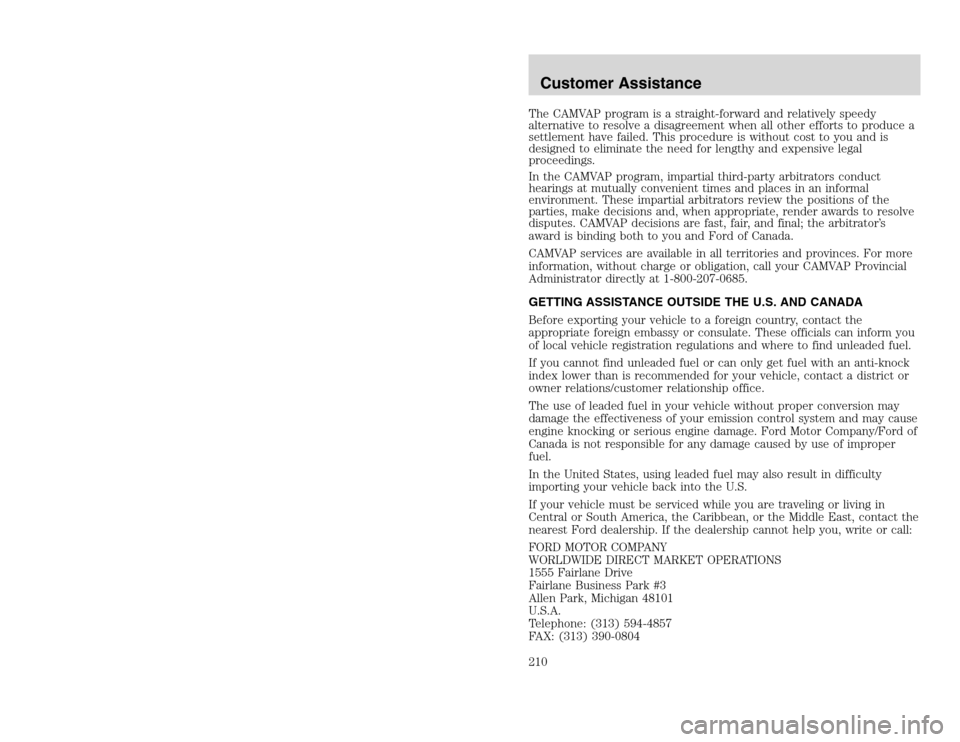
20815.psp Ford O/G 2002 Excursion English 4th Print 2C3J-19A321-HB 04/24/2003 09:14:57 105 B
The CAMVAP program is a straight-forward and relatively speedy
alternative to resolve a disagreement when all other efforts to produce a
settlement have failed. This procedure is without cost to you and is
designed to eliminate the need for lengthy and expensive legal
proceedings.
In the CAMVAP program, impartial third-party arbitrators conduct
hearings at mutually convenient times and places in an informal
environment. These impartial arbitrators review the positions of the
parties, make decisions and, when appropriate, render awards to resolve
disputes. CAMVAP decisions are fast, fair, and final; the arbitrator’s
award is binding both to you and Ford of Canada.
CAMVAP services are available in all territories and provinces. For more
information, without charge or obligation, call your CAMVAP Provincial
Administrator directly at 1-800-207-0685.
GETTING ASSISTANCE OUTSIDE THE U.S. AND CANADA
Before exporting your vehicle to a foreign country, contact the
appropriate foreign embassy or consulate. These officials can inform you
of local vehicle registration regulations and where to find unleaded fuel.
If you cannot find unleaded fuel or can only get fuel with an anti-knock
index lower than is recommended for your vehicle, contact a district or
owner relations/customer relationship office.
The use of leaded fuel in your vehicle without proper conversion may
damage the effectiveness of your emission control system and may cause
engine knocking or serious engine damage. Ford Motor Company/Ford of
Canada is not responsible for any damage caused by use of improper
fuel.
In the United States, using leaded fuel may also result in difficulty
importing your vehicle back into the U.S.
If your vehicle must be serviced while you are traveling or living in
Central or South America, the Caribbean, or the Middle East, contact the
nearest Ford dealership. If the dealership cannot help you, write or call:
FORD MOTOR COMPANY
WORLDWIDE DIRECT MARKET OPERATIONS
1555 Fairlane Drive
Fairlane Business Park #3
Allen Park, Michigan 48101
U.S.A.
Telephone: (313) 594-4857
FAX: (313) 390-0804Customer Assistance210
The CAMVAP program is a straight-forward and relatively speedy
alternative to resolve a disagreement when all other efforts to produce a
settlement have failed. This procedure is without cost to you and is
designed to eliminate the need for lengthy and expensive legal
proceedings.
In the CAMVAP program, impartial third-party arbitrators conduct
hearings at mutually convenient times and places in an informal
environment. These impartial arbitrators review the positions of the
parties, make decisions and, when appropriate, render awards to resolve
disputes. CAMVAP decisions are fast, fair, and final; the arbitrator’s
award is binding both to you and Ford of Canada.
CAMVAP services are available in all territories and provinces. For more
information, without charge or obligation, call your CAMVAP Provincial
Administrator directly at 1-800-207-0685.
GETTING ASSISTANCE OUTSIDE THE U.S. AND CANADA
Before exporting your vehicle to a foreign country, contact the
appropriate foreign embassy or consulate. These officials can inform you
of local vehicle registration regulations and where to find unleaded fuel.
If you cannot find unleaded fuel or can only get fuel with an anti-knock
index lower than is recommended for your vehicle, contact a district or
owner relations/customer relationship office.
The use of leaded fuel in your vehicle without proper conversion may
damage the effectiveness of your emission control system and may cause
engine knocking or serious engine damage. Ford Motor Company/Ford of
Canada is not responsible for any damage caused by use of improper
fuel.
In the United States, using leaded fuel may also result in difficulty
importing your vehicle back into the U.S.
If your vehicle must be serviced while you are traveling or living in
Central or South America, the Caribbean, or the Middle East, contact the
nearest Ford dealership. If the dealership cannot help you, write or call:
FORD MOTOR COMPANY
WORLDWIDE DIRECT MARKET OPERATIONS
1555 Fairlane Drive
Fairlane Business Park #3
Allen Park, Michigan 48101
U.S.A.
Telephone: (313) 594-4857
FAX: (313) 390-0804Customer Assistance210
Page 240 of 272
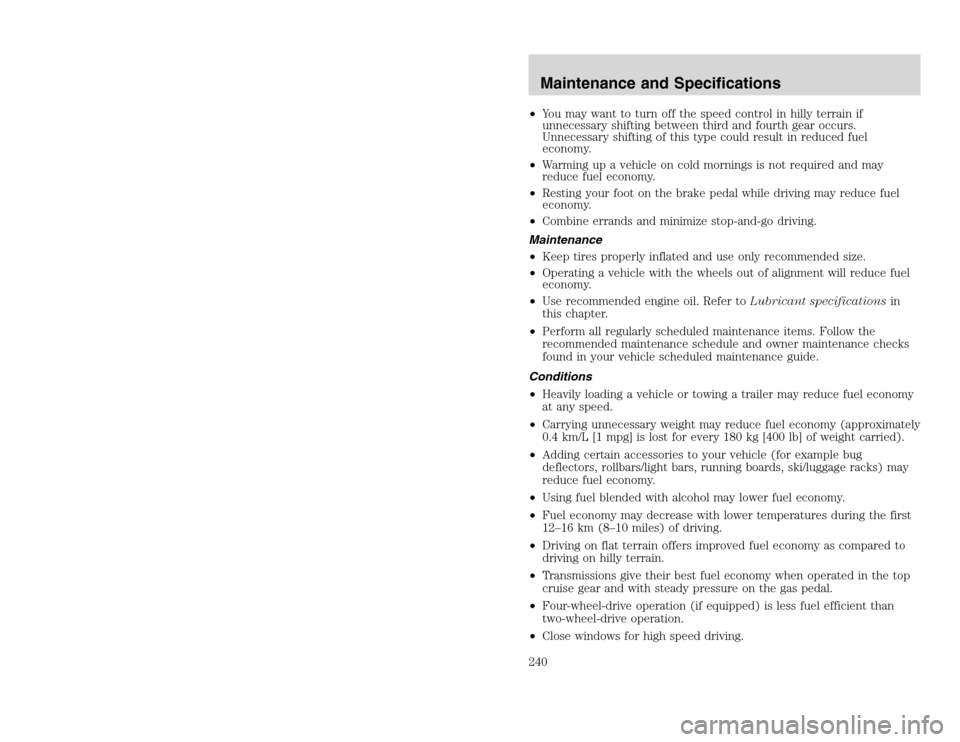
20815.psp Ford O/G 2002 Excursion English 4th Print 2C3J-19A321-HB 04/24/2003 09:14:57 120 B
•You may want to turn off the speed control in hilly terrain if
unnecessary shifting between third and fourth gear occurs.
Unnecessary shifting of this type could result in reduced fuel
economy.
•Warming up a vehicle on cold mornings is not required and may
reduce fuel economy.
•Resting your foot on the brake pedal while driving may reduce fuel
economy.
•Combine errands and minimize stop-and-go driving.
Maintenance
•Keep tires properly inflated and use only recommended size.
•Operating a vehicle with the wheels out of alignment will reduce fuel
economy.
•Use recommended engine oil. Refer toLubricant specificationsin
this chapter.
•Perform all regularly scheduled maintenance items. Follow the
recommended maintenance schedule and owner maintenance checks
found in your vehicle scheduled maintenance guide.
Conditions
•Heavily loading a vehicle or towing a trailer may reduce fuel economy
at any speed.
•Carrying unnecessary weight may reduce fuel economy (approximately
0.4 km/L [1 mpg] is lost for every 180 kg [400 lb] of weight carried).
•Adding certain accessories to your vehicle (for example bug
deflectors, rollbars/light bars, running boards, ski/luggage racks) may
reduce fuel economy.
•Using fuel blended with alcohol may lower fuel economy.
•Fuel economy may decrease with lower temperatures during the first
12–16 km (8–10 miles) of driving.
•Driving on flat terrain offers improved fuel economy as compared to
driving on hilly terrain.
•Transmissions give their best fuel economy when operated in the top
cruise gear and with steady pressure on the gas pedal.
•Four-wheel-drive operation (if equipped) is less fuel efficient than
two-wheel-drive operation.
•Close windows for high speed driving.Maintenance and Specifications240
•You may want to turn off the speed control in hilly terrain if
unnecessary shifting between third and fourth gear occurs.
Unnecessary shifting of this type could result in reduced fuel
economy.
•Warming up a vehicle on cold mornings is not required and may
reduce fuel economy.
•Resting your foot on the brake pedal while driving may reduce fuel
economy.
•Combine errands and minimize stop-and-go driving.
Maintenance
•Keep tires properly inflated and use only recommended size.
•Operating a vehicle with the wheels out of alignment will reduce fuel
economy.
•Use recommended engine oil. Refer toLubricant specificationsin
this chapter.
•Perform all regularly scheduled maintenance items. Follow the
recommended maintenance schedule and owner maintenance checks
found in your vehicle scheduled maintenance guide.
Conditions
•Heavily loading a vehicle or towing a trailer may reduce fuel economy
at any speed.
•Carrying unnecessary weight may reduce fuel economy (approximately
0.4 km/L [1 mpg] is lost for every 180 kg [400 lb] of weight carried).
•Adding certain accessories to your vehicle (for example bug
deflectors, rollbars/light bars, running boards, ski/luggage racks) may
reduce fuel economy.
•Using fuel blended with alcohol may lower fuel economy.
•Fuel economy may decrease with lower temperatures during the first
12–16 km (8–10 miles) of driving.
•Driving on flat terrain offers improved fuel economy as compared to
driving on hilly terrain.
•Transmissions give their best fuel economy when operated in the top
cruise gear and with steady pressure on the gas pedal.
•Four-wheel-drive operation (if equipped) is less fuel efficient than
two-wheel-drive operation.
•Close windows for high speed driving.Maintenance and Specifications240
Page 241 of 272
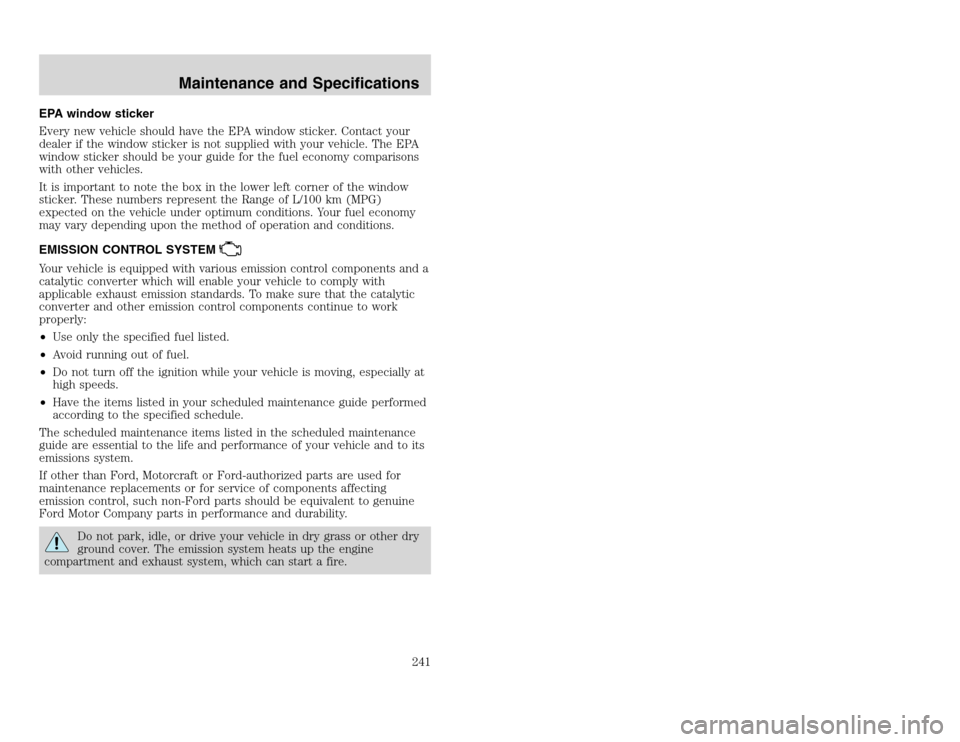
20815.psp Ford O/G 2002 Excursion English 4th Print 2C3J-19A321-HB 04/24/2003 09:14:57 121 A
EPA window sticker
Every new vehicle should have the EPA window sticker. Contact your
dealer if the window sticker is not supplied with your vehicle. The EPA
window sticker should be your guide for the fuel economy comparisons
with other vehicles.
It is important to note the box in the lower left corner of the window
sticker. These numbers represent the Range of L/100 km (MPG)
expected on the vehicle under optimum conditions. Your fuel economy
may vary depending upon the method of operation and conditions.
EMISSION CONTROL SYSTEMYour vehicle is equipped with various emission control components and a
catalytic converter which will enable your vehicle to comply with
applicable exhaust emission standards. To make sure that the catalytic
converter and other emission control components continue to work
properly:
•Use only the specified fuel listed.
•Avoid running out of fuel.
•Do not turn off the ignition while your vehicle is moving, especially at
high speeds.
•Have the items listed in your scheduled maintenance guide performed
according to the specified schedule.
The scheduled maintenance items listed in the scheduled maintenance
guide are essential to the life and performance of your vehicle and to its
emissions system.
If other than Ford, Motorcraft or Ford-authorized parts are used for
maintenance replacements or for service of components affecting
emission control, such non-Ford parts should be equivalent to genuine
Ford Motor Company parts in performance and durability.
Do not park, idle, or drive your vehicle in dry grass or other dry
ground cover. The emission system heats up the engine
compartment and exhaust system, which can start a fire.
Maintenance and Specifications
241
EPA window sticker
Every new vehicle should have the EPA window sticker. Contact your
dealer if the window sticker is not supplied with your vehicle. The EPA
window sticker should be your guide for the fuel economy comparisons
with other vehicles.
It is important to note the box in the lower left corner of the window
sticker. These numbers represent the Range of L/100 km (MPG)
expected on the vehicle under optimum conditions. Your fuel economy
may vary depending upon the method of operation and conditions.
EMISSION CONTROL SYSTEMYour vehicle is equipped with various emission control components and a
catalytic converter which will enable your vehicle to comply with
applicable exhaust emission standards. To make sure that the catalytic
converter and other emission control components continue to work
properly:
•Use only the specified fuel listed.
•Avoid running out of fuel.
•Do not turn off the ignition while your vehicle is moving, especially at
high speeds.
•Have the items listed in your scheduled maintenance guide performed
according to the specified schedule.
The scheduled maintenance items listed in the scheduled maintenance
guide are essential to the life and performance of your vehicle and to its
emissions system.
If other than Ford, Motorcraft or Ford-authorized parts are used for
maintenance replacements or for service of components affecting
emission control, such non-Ford parts should be equivalent to genuine
Ford Motor Company parts in performance and durability.
Do not park, idle, or drive your vehicle in dry grass or other dry
ground cover. The emission system heats up the engine
compartment and exhaust system, which can start a fire.
Maintenance and Specifications
241
Page 250 of 272
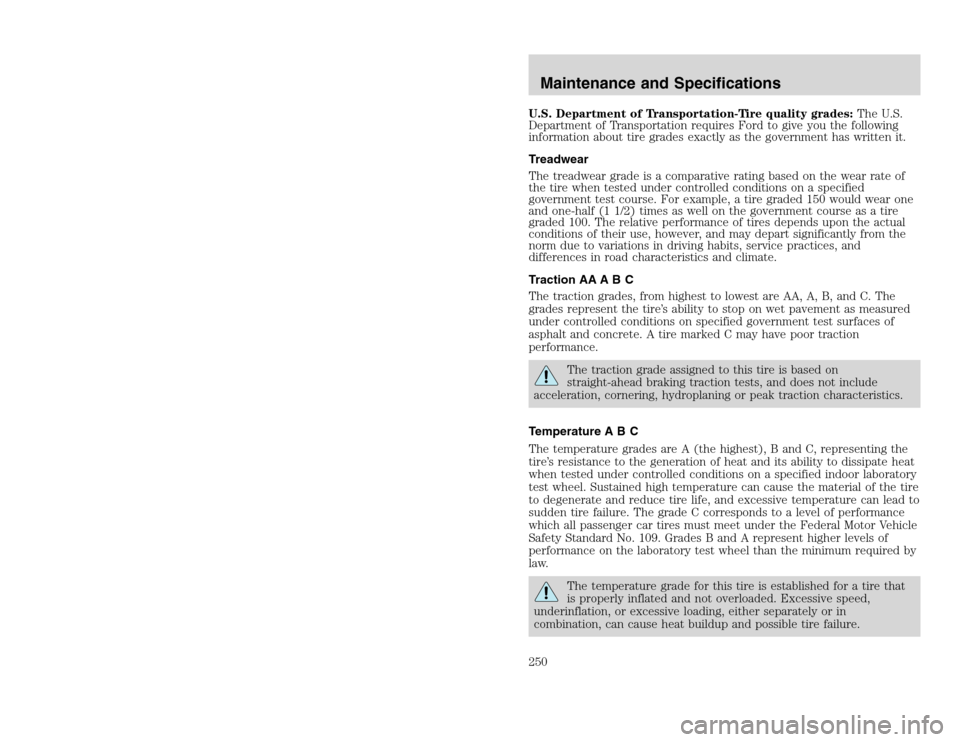
20815.psp Ford O/G 2002 Excursion English 4th Print 2C3J-19A321-HB 04/24/2003 09:14:57 125 B
U.S. Department of Transportation-Tire quality grades:The U.S.
Department of Transportation requires Ford to give you the following
information about tire grades exactly as the government has written it.
Treadwear
The treadwear grade is a comparative rating based on the wear rate of
the tire when tested under controlled conditions on a specified
government test course. For example, a tire graded 150 would wear one
and one-half (1 1/2) times as well on the government course as a tire
graded 100. The relative performance of tires depends upon the actual
conditions of their use, however, and may depart significantly from the
norm due to variations in driving habits, service practices, and
differences in road characteristics and climate.
Traction AA A B C
The traction grades, from highest to lowest are AA, A, B, and C. The
grades represent the tire’s ability to stop on wet pavement as measured
under controlled conditions on specified government test surfaces of
asphalt and concrete. A tire marked C may have poor traction
performance.
The traction grade assigned to this tire is based on
straight-ahead braking traction tests, and does not include
acceleration, cornering, hydroplaning or peak traction characteristics.
Temperature A B C
The temperature grades are A (the highest), B and C, representing the
tire’s resistance to the generation of heat and its ability to dissipate heat
when tested under controlled conditions on a specified indoor laboratory
test wheel. Sustained high temperature can cause the material of the tire
to degenerate and reduce tire life, and excessive temperature can lead to
sudden tire failure. The grade C corresponds to a level of performance
which all passenger car tires must meet under the Federal Motor Vehicle
Safety Standard No. 109. Grades B and A represent higher levels of
performance on the laboratory test wheel than the minimum required by
law.The temperature grade for this tire is established for a tire that
is properly inflated and not overloaded. Excessive speed,
underinflation, or excessive loading, either separately or in
combination, can cause heat buildup and possible tire failure.
Maintenance and Specifications250
U.S. Department of Transportation-Tire quality grades:The U.S.
Department of Transportation requires Ford to give you the following
information about tire grades exactly as the government has written it.
Treadwear
The treadwear grade is a comparative rating based on the wear rate of
the tire when tested under controlled conditions on a specified
government test course. For example, a tire graded 150 would wear one
and one-half (1 1/2) times as well on the government course as a tire
graded 100. The relative performance of tires depends upon the actual
conditions of their use, however, and may depart significantly from the
norm due to variations in driving habits, service practices, and
differences in road characteristics and climate.
Traction AA A B C
The traction grades, from highest to lowest are AA, A, B, and C. The
grades represent the tire’s ability to stop on wet pavement as measured
under controlled conditions on specified government test surfaces of
asphalt and concrete. A tire marked C may have poor traction
performance.
The traction grade assigned to this tire is based on
straight-ahead braking traction tests, and does not include
acceleration, cornering, hydroplaning or peak traction characteristics.
Temperature A B C
The temperature grades are A (the highest), B and C, representing the
tire’s resistance to the generation of heat and its ability to dissipate heat
when tested under controlled conditions on a specified indoor laboratory
test wheel. Sustained high temperature can cause the material of the tire
to degenerate and reduce tire life, and excessive temperature can lead to
sudden tire failure. The grade C corresponds to a level of performance
which all passenger car tires must meet under the Federal Motor Vehicle
Safety Standard No. 109. Grades B and A represent higher levels of
performance on the laboratory test wheel than the minimum required by
law.The temperature grade for this tire is established for a tire that
is properly inflated and not overloaded. Excessive speed,
underinflation, or excessive loading, either separately or in
combination, can cause heat buildup and possible tire failure.
Maintenance and Specifications250
Page 253 of 272

20815.psp Ford O/G 2002 Excursion English 4th Print 2C3J-19A321-HB 04/24/2003 09:14:57 127 A
Do not replace your tires with “high performance” tires or larger
size tires.Failure to follow these precautions may adversely affect the
handling of the vehicle and make it easier for the driver to lose
control and roll over.
Tires that are larger or smaller than your vehicle’s original tires may also
affect the accuracy of your speedometer.
SNOW TIRES AND CHAINSSnow tires must be the same size and grade as the tires you
currently have on your vehicle.
The tires on your vehicle have all weather treads to provide traction in
rain and snow. However, in some climates, you may need to use snow
tires and chains. If you need to use chains, it is recommended that steel
wheels (of the same size and specifications) be used as chains may chip
aluminum wheels.
Follow these guidelines when using snow tires and chains:
•Use only SAE Class S chains.
•Install chains securely, verifying that the chains do not touch any
wiring, brake lines or fuel lines.
•Drive cautiously. If you hear the chains rub or bang against your
vehicle, stop and re-tighten the chains. If this does not work, remove
the chains to prevent damage to your vehicle.
•If possible, avoid fully loading your vehicle.
•Remove the tire chains when they are no longer needed. Do not use
tire chains on dry roads.
•The suspension insulation and bumpers will help prevent vehicle
damage. Do not remove these components from your vehicle when
using snow tires and chains.
Maintenance and Specifications
253
Do not replace your tires with “high performance” tires or larger
size tires.Failure to follow these precautions may adversely affect the
handling of the vehicle and make it easier for the driver to lose
control and roll over.
Tires that are larger or smaller than your vehicle’s original tires may also
affect the accuracy of your speedometer.
SNOW TIRES AND CHAINSSnow tires must be the same size and grade as the tires you
currently have on your vehicle.
The tires on your vehicle have all weather treads to provide traction in
rain and snow. However, in some climates, you may need to use snow
tires and chains. If you need to use chains, it is recommended that steel
wheels (of the same size and specifications) be used as chains may chip
aluminum wheels.
Follow these guidelines when using snow tires and chains:
•Use only SAE Class S chains.
•Install chains securely, verifying that the chains do not touch any
wiring, brake lines or fuel lines.
•Drive cautiously. If you hear the chains rub or bang against your
vehicle, stop and re-tighten the chains. If this does not work, remove
the chains to prevent damage to your vehicle.
•If possible, avoid fully loading your vehicle.
•Remove the tire chains when they are no longer needed. Do not use
tire chains on dry roads.
•The suspension insulation and bumpers will help prevent vehicle
damage. Do not remove these components from your vehicle when
using snow tires and chains.
Maintenance and Specifications
253
Page 267 of 272
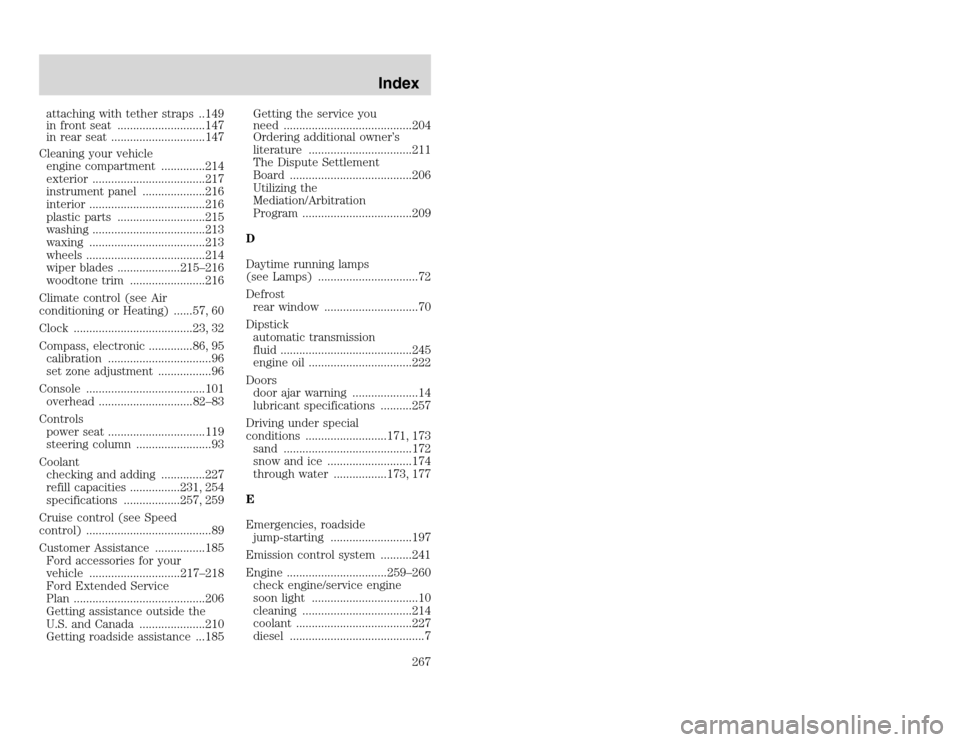
20815.psp Ford O/G 2002 Excursion English 4th Print 2C3J-19A321-HB 04/24/2003 09:14:57 134 A
attaching with tether straps ..149
in front seat ............................147
in rear seat ..............................147
Cleaning your vehicle
engine compartment ..............214
exterior ....................................217
instrument panel ....................216
interior .....................................216
plastic parts ............................215
washing ....................................213
waxing .....................................213
wheels ......................................214
wiper blades ....................215–216
woodtone trim ........................216
Climate control (see Air
conditioning or Heating) ......57, 60
Clock ......................................23, 32
Compass, electronic ..............86, 95
calibration .................................96
set zone adjustment .................96
Console ......................................101
overhead ..............................82–83
Controls
power seat ...............................119
steering column ........................93
Coolant
checking and adding ..............227
refill capacities ................231, 254
specifications ..................257, 259
Cruise control (see Speed
control) ........................................89
Customer Assistance ................185
Ford accessories for your
vehicle .............................217–218
Ford Extended Service
Plan ..........................................206
Getting assistance outside the
U.S. and Canada .....................210
Getting roadside assistance ...185Getting the service you
need .........................................204
Ordering additional owner’s
literature .................................211
The Dispute Settlement
Board .......................................206
Utilizing the
Mediation/Arbitration
Program ...................................209
D
Daytime running lamps
(see Lamps) ................................72
Defrost
rear window ..............................70
Dipstick
automatic transmission
fluid ..........................................245
engine oil .................................222
Doors
door ajar warning .....................14
lubricant specifications ..........257
Driving under special
conditions ..........................171, 173
sand .........................................172
snow and ice ...........................174
through water .................173, 177
E
Emergencies, roadside
jump-starting ..........................197
Emission control system ..........241
Engine ................................259–260
check engine/service engine
soon light ..................................10
cleaning ...................................214
coolant .....................................227
diesel ...........................................7
Index
267
attaching with tether straps ..149
in front seat ............................147
in rear seat ..............................147
Cleaning your vehicle
engine compartment ..............214
exterior ....................................217
instrument panel ....................216
interior .....................................216
plastic parts ............................215
washing ....................................213
waxing .....................................213
wheels ......................................214
wiper blades ....................215–216
woodtone trim ........................216
Climate control (see Air
conditioning or Heating) ......57, 60
Clock ......................................23, 32
Compass, electronic ..............86, 95
calibration .................................96
set zone adjustment .................96
Console ......................................101
overhead ..............................82–83
Controls
power seat ...............................119
steering column ........................93
Coolant
checking and adding ..............227
refill capacities ................231, 254
specifications ..................257, 259
Cruise control (see Speed
control) ........................................89
Customer Assistance ................185
Ford accessories for your
vehicle .............................217–218
Ford Extended Service
Plan ..........................................206
Getting assistance outside the
U.S. and Canada .....................210
Getting roadside assistance ...185Getting the service you
need .........................................204
Ordering additional owner’s
literature .................................211
The Dispute Settlement
Board .......................................206
Utilizing the
Mediation/Arbitration
Program ...................................209
D
Daytime running lamps
(see Lamps) ................................72
Defrost
rear window ..............................70
Dipstick
automatic transmission
fluid ..........................................245
engine oil .................................222
Doors
door ajar warning .....................14
lubricant specifications ..........257
Driving under special
conditions ..........................171, 173
sand .........................................172
snow and ice ...........................174
through water .................173, 177
E
Emergencies, roadside
jump-starting ..........................197
Emission control system ..........241
Engine ................................259–260
check engine/service engine
soon light ..................................10
cleaning ...................................214
coolant .....................................227
diesel ...........................................7
Index
267
Page 268 of 272
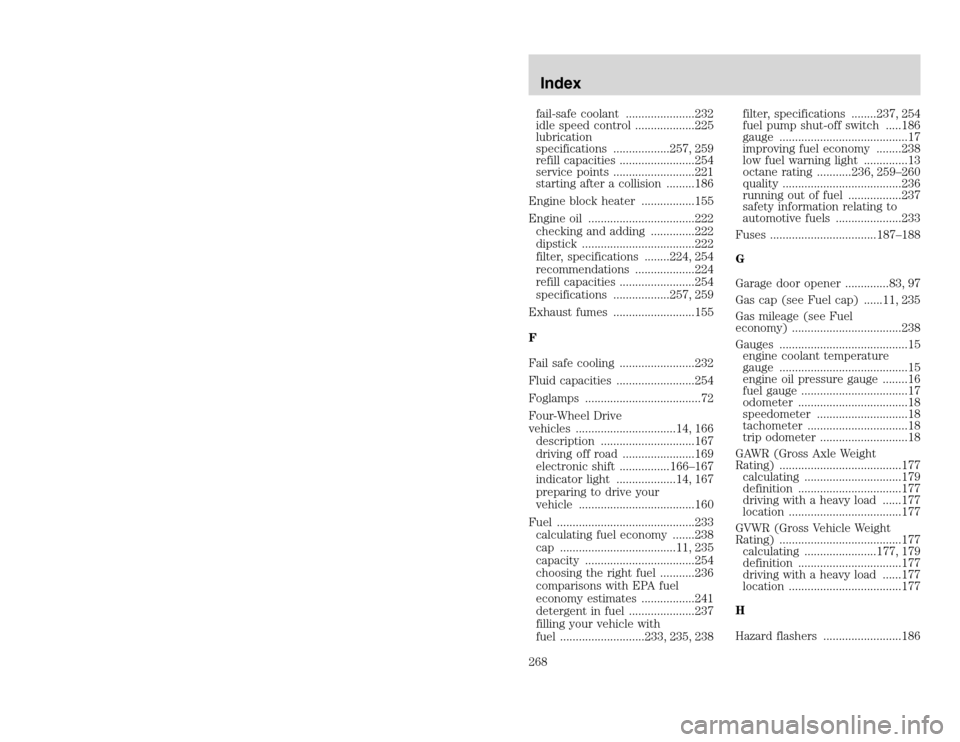
20815.psp Ford O/G 2002 Excursion English 4th Print 2C3J-19A321-HB 04/24/2003 09:14:57 134 B
fail-safe coolant ......................232
idle speed control ...................225
lubrication
specifications ..................257, 259
refill capacities ........................254
service points ..........................221
starting after a collision .........186
Engine block heater .................155
Engine oil ..................................222
checking and adding ..............222
dipstick ....................................222
filter, specifications ........224, 254
recommendations ...................224
refill capacities ........................254
specifications ..................257, 259
Exhaust fumes ..........................155
F
Fail safe cooling ........................232
Fluid capacities .........................254
Foglamps .....................................72
Four-Wheel Drive
vehicles ................................14, 166
description ..............................167
driving off road .......................169
electronic shift ................166–167
indicator light ...................14, 167
preparing to drive your
vehicle .....................................160
Fuel ............................................233
calculating fuel economy .......238
cap .....................................11, 235
capacity ...................................254
choosing the right fuel ...........236
comparisons with EPA fuel
economy estimates .................241
detergent in fuel .....................237
filling your vehicle with
fuel ...........................233, 235, 238filter, specifications ........237, 254
fuel pump shut-off switch .....186
gauge .........................................17
improving fuel economy ........238
low fuel warning light ..............13
octane rating ...........236, 259–260
quality ......................................236
running out of fuel .................237
safety information relating to
automotive fuels .....................233
Fuses ..................................187–188
G
Garage door opener ..............83, 97
Gas cap (see Fuel cap) ......11, 235
Gas mileage (see Fuel
economy) ...................................238
Gauges .........................................15
engine coolant temperature
gauge .........................................15
engine oil pressure gauge ........16
fuel gauge ..................................17
odometer ...................................18
speedometer .............................18
tachometer ................................18
trip odometer ............................18
GAWR (Gross Axle Weight
Rating) .......................................177
calculating ...............................179
definition .................................177
driving with a heavy load ......177
location ....................................177
GVWR (Gross Vehicle Weight
Rating) .......................................177
calculating .......................177, 179
definition .................................177
driving with a heavy load ......177
location ....................................177
H
Hazard flashers .........................186Index268
fail-safe coolant ......................232
idle speed control ...................225
lubrication
specifications ..................257, 259
refill capacities ........................254
service points ..........................221
starting after a collision .........186
Engine block heater .................155
Engine oil ..................................222
checking and adding ..............222
dipstick ....................................222
filter, specifications ........224, 254
recommendations ...................224
refill capacities ........................254
specifications ..................257, 259
Exhaust fumes ..........................155
F
Fail safe cooling ........................232
Fluid capacities .........................254
Foglamps .....................................72
Four-Wheel Drive
vehicles ................................14, 166
description ..............................167
driving off road .......................169
electronic shift ................166–167
indicator light ...................14, 167
preparing to drive your
vehicle .....................................160
Fuel ............................................233
calculating fuel economy .......238
cap .....................................11, 235
capacity ...................................254
choosing the right fuel ...........236
comparisons with EPA fuel
economy estimates .................241
detergent in fuel .....................237
filling your vehicle with
fuel ...........................233, 235, 238filter, specifications ........237, 254
fuel pump shut-off switch .....186
gauge .........................................17
improving fuel economy ........238
low fuel warning light ..............13
octane rating ...........236, 259–260
quality ......................................236
running out of fuel .................237
safety information relating to
automotive fuels .....................233
Fuses ..................................187–188
G
Garage door opener ..............83, 97
Gas cap (see Fuel cap) ......11, 235
Gas mileage (see Fuel
economy) ...................................238
Gauges .........................................15
engine coolant temperature
gauge .........................................15
engine oil pressure gauge ........16
fuel gauge ..................................17
odometer ...................................18
speedometer .............................18
tachometer ................................18
trip odometer ............................18
GAWR (Gross Axle Weight
Rating) .......................................177
calculating ...............................179
definition .................................177
driving with a heavy load ......177
location ....................................177
GVWR (Gross Vehicle Weight
Rating) .......................................177
calculating .......................177, 179
definition .................................177
driving with a heavy load ......177
location ....................................177
H
Hazard flashers .........................186Index268
Page 270 of 272
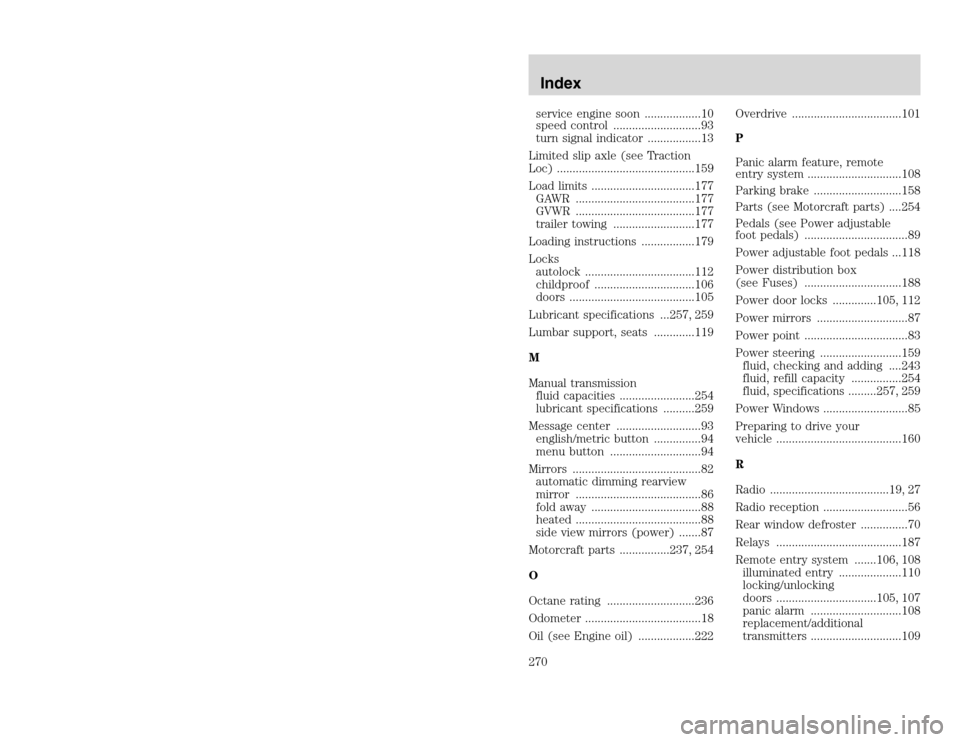
20815.psp Ford O/G 2002 Excursion English 4th Print 2C3J-19A321-HB 04/24/2003 09:14:57 135 B
service engine soon ..................10
speed control ............................93
turn signal indicator .................13
Limited slip axle (see Traction
Loc) ............................................159
Load limits .................................177
GAWR ......................................177
GVWR ......................................177
trailer towing ..........................177
Loading instructions .................179
Locks
autolock ...................................112
childproof ................................106
doors ........................................105
Lubricant specifications ...257, 259
Lumbar support, seats .............119
M
Manual transmission
fluid capacities ........................254
lubricant specifications ..........259
Message center ...........................93
english/metric button ...............94
menu button .............................94
Mirrors .........................................82
automatic dimming rearview
mirror ........................................86
fold away ...................................88
heated ........................................88
side view mirrors (power) .......87
Motorcraft parts ................237, 254
O
Octane rating ............................236
Odometer .....................................18
Oil (see Engine oil) ..................222Overdrive ...................................101
P
Panic alarm feature, remote
entry system ..............................108
Parking brake ............................158
Parts (see Motorcraft parts) ....254
Pedals (see Power adjustable
foot pedals) .................................89
Power adjustable foot pedals ...118
Power distribution box
(see Fuses) ...............................188
Power door locks ..............105, 112
Power mirrors .............................87
Power point .................................83
Power steering ..........................159
fluid, checking and adding ....243
fluid, refill capacity ................254
fluid, specifications .........257, 259
Power Windows ...........................85
Preparing to drive your
vehicle ........................................160
R
Radio ......................................19, 27
Radio reception ...........................56
Rear window defroster ...............70
Relays ........................................187
Remote entry system .......106, 108
illuminated entry ....................110
locking/unlocking
doors ................................105, 107
panic alarm .............................108
replacement/additional
transmitters .............................109Index270
service engine soon ..................10
speed control ............................93
turn signal indicator .................13
Limited slip axle (see Traction
Loc) ............................................159
Load limits .................................177
GAWR ......................................177
GVWR ......................................177
trailer towing ..........................177
Loading instructions .................179
Locks
autolock ...................................112
childproof ................................106
doors ........................................105
Lubricant specifications ...257, 259
Lumbar support, seats .............119
M
Manual transmission
fluid capacities ........................254
lubricant specifications ..........259
Message center ...........................93
english/metric button ...............94
menu button .............................94
Mirrors .........................................82
automatic dimming rearview
mirror ........................................86
fold away ...................................88
heated ........................................88
side view mirrors (power) .......87
Motorcraft parts ................237, 254
O
Octane rating ............................236
Odometer .....................................18
Oil (see Engine oil) ..................222Overdrive ...................................101
P
Panic alarm feature, remote
entry system ..............................108
Parking brake ............................158
Parts (see Motorcraft parts) ....254
Pedals (see Power adjustable
foot pedals) .................................89
Power adjustable foot pedals ...118
Power distribution box
(see Fuses) ...............................188
Power door locks ..............105, 112
Power mirrors .............................87
Power point .................................83
Power steering ..........................159
fluid, checking and adding ....243
fluid, refill capacity ................254
fluid, specifications .........257, 259
Power Windows ...........................85
Preparing to drive your
vehicle ........................................160
R
Radio ......................................19, 27
Radio reception ...........................56
Rear window defroster ...............70
Relays ........................................187
Remote entry system .......106, 108
illuminated entry ....................110
locking/unlocking
doors ................................105, 107
panic alarm .............................108
replacement/additional
transmitters .............................109Index270
Page 271 of 272
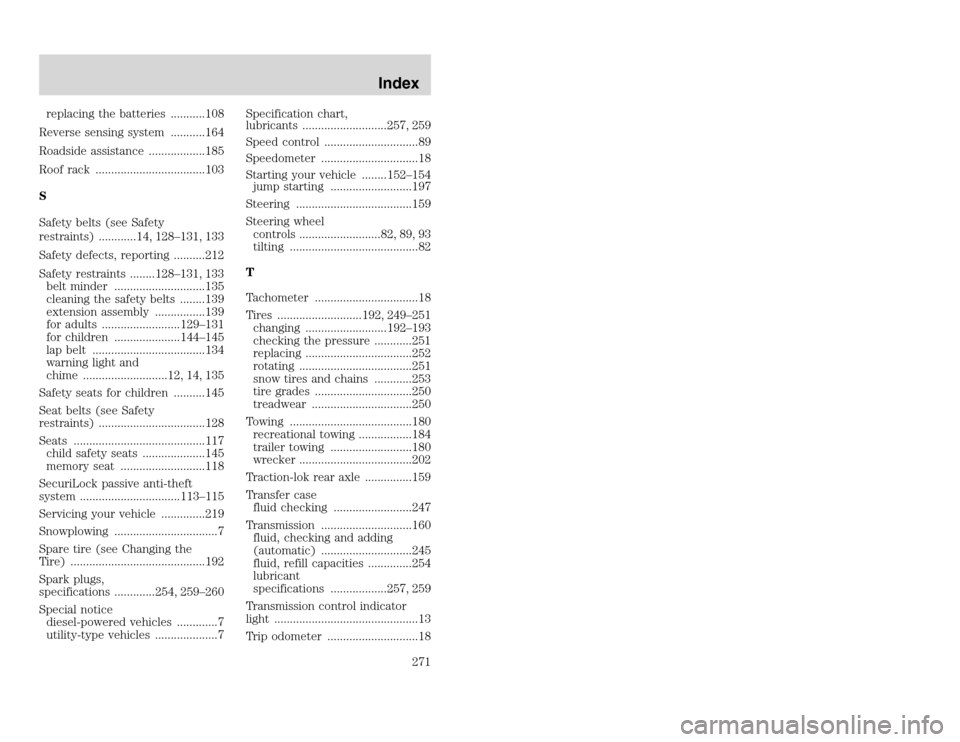
20815.psp Ford O/G 2002 Excursion English 4th Print 2C3J-19A321-HB 04/24/2003 09:14:57 136 A
replacing the batteries ...........108
Reverse sensing system ...........164
Roadside assistance ..................185
Roof rack ...................................103
S
Safety belts (see Safety
restraints) ............14, 128–131, 133
Safety defects, reporting ..........212
Safety restraints ........128–131, 133
belt minder .............................135
cleaning the safety belts ........139
extension assembly ................139
for adults .........................129–131
for children .....................144–145
lap belt ....................................134
warning light and
chime ...........................12, 14, 135
Safety seats for children ..........145
Seat belts (see Safety
restraints) ..................................128
Seats ..........................................117
child safety seats ....................145
memory seat ...........................118
SecuriLock passive anti-theft
system ................................113–115
Servicing your vehicle ..............219
Snowplowing .................................7
Spare tire (see Changing the
Tire) ...........................................192
Spark plugs,
specifications .............254, 259–260
Special notice
diesel-powered vehicles .............7
utility-type vehicles ....................7Specification chart,
lubricants ...........................257, 259
Speed control ..............................89
Speedometer ...............................18
Starting your vehicle ........152–154
jump starting ..........................197
Steering .....................................159
Steering wheel
controls ..........................82, 89, 93
tilting .........................................82
T
Tachometer .................................18
Tires ...........................192, 249–251
changing ..........................192–193
checking the pressure ............251
replacing ..................................252
rotating ....................................251
snow tires and chains ............253
tire grades ...............................250
treadwear ................................250
Towing .......................................180
recreational towing .................184
trailer towing ..........................180
wrecker ....................................202
Traction-lok rear axle ...............159
Transfer case
fluid checking .........................247
Transmission .............................160
fluid, checking and adding
(automatic) .............................245
fluid, refill capacities ..............254
lubricant
specifications ..................257, 259
Transmission control indicator
light ..............................................13
Trip odometer .............................18
Index
271
replacing the batteries ...........108
Reverse sensing system ...........164
Roadside assistance ..................185
Roof rack ...................................103
S
Safety belts (see Safety
restraints) ............14, 128–131, 133
Safety defects, reporting ..........212
Safety restraints ........128–131, 133
belt minder .............................135
cleaning the safety belts ........139
extension assembly ................139
for adults .........................129–131
for children .....................144–145
lap belt ....................................134
warning light and
chime ...........................12, 14, 135
Safety seats for children ..........145
Seat belts (see Safety
restraints) ..................................128
Seats ..........................................117
child safety seats ....................145
memory seat ...........................118
SecuriLock passive anti-theft
system ................................113–115
Servicing your vehicle ..............219
Snowplowing .................................7
Spare tire (see Changing the
Tire) ...........................................192
Spark plugs,
specifications .............254, 259–260
Special notice
diesel-powered vehicles .............7
utility-type vehicles ....................7Specification chart,
lubricants ...........................257, 259
Speed control ..............................89
Speedometer ...............................18
Starting your vehicle ........152–154
jump starting ..........................197
Steering .....................................159
Steering wheel
controls ..........................82, 89, 93
tilting .........................................82
T
Tachometer .................................18
Tires ...........................192, 249–251
changing ..........................192–193
checking the pressure ............251
replacing ..................................252
rotating ....................................251
snow tires and chains ............253
tire grades ...............................250
treadwear ................................250
Towing .......................................180
recreational towing .................184
trailer towing ..........................180
wrecker ....................................202
Traction-lok rear axle ...............159
Transfer case
fluid checking .........................247
Transmission .............................160
fluid, checking and adding
(automatic) .............................245
fluid, refill capacities ..............254
lubricant
specifications ..................257, 259
Transmission control indicator
light ..............................................13
Trip odometer .............................18
Index
271